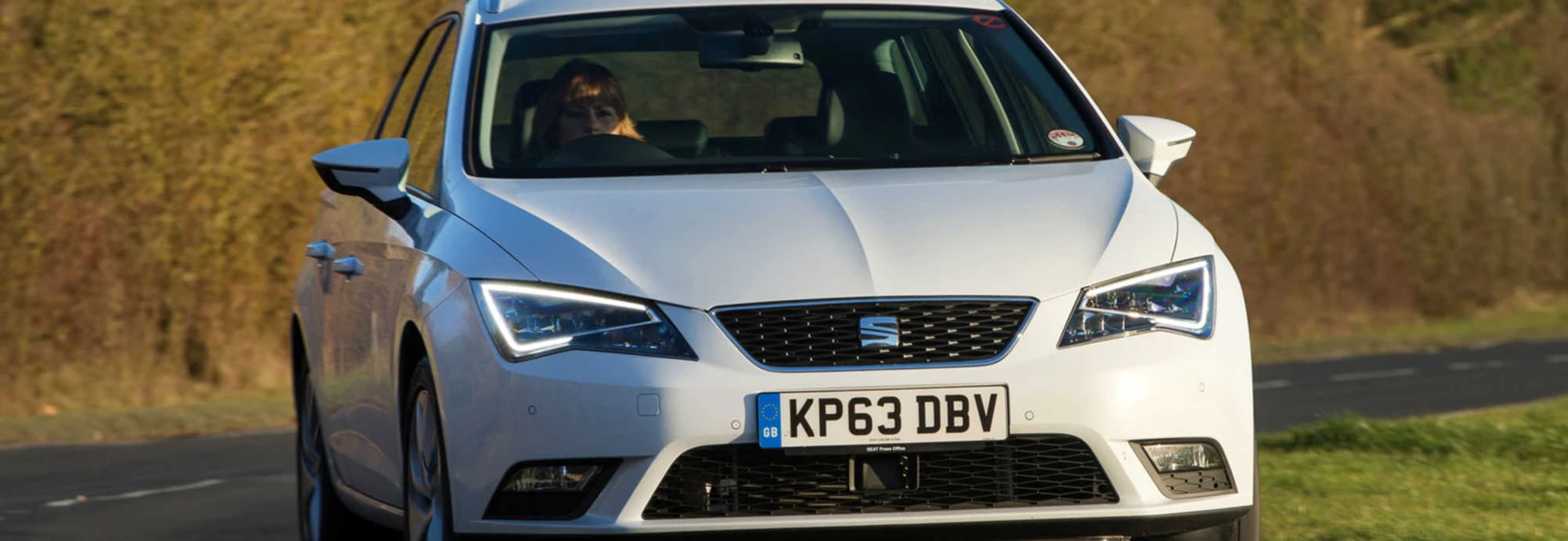ST stands for "Sports Tourer", which is SEAT's term for an estate car. The Leon ST is nearly a foot longer than the three- and five-door hatchbacks to permit a load capacity which, while not class-leading, is nevertheless very good.
Nearly all the engines fitted to the hatches are also offered in the ST, the most recent addition being the 276bhp 2-litre turbo petrol unit in the high-performance Cupra 280. There are four other petrol engines and four diesels in the range, with power outputs from 104bhp to 181bhp. Manual transmission is the norm, but a six-speed DSG semi-automatic gearbox is also available.
Performance
As the spread of engine power outputs suggests, the ST has a very wide range of capabilities in this area. The Cupra 280, SEAT's fastest ever estate, can accelerate from 0-62mph in 6.1 seconds with a manual transmission and 6.0 seconds with DSG. That's three tenths slower than the lighter hatchback models can manage with the same powertrain, but it's still well into hot hatch territory.
The 104bhp 1.6-litre TDI takes 11.1 seconds to do the same thing. That's a full second slower than the 109bhp 1.2-litre TSI turbo petrol car, but in normal driving the diesel feels quicker because it produces much more power at lower engine speeds. At 2,000rpm, for example, it's capable of 70bhp while the 1.2-litre TSI can manage only 49bhp.
Before the Cupra 280 came along, the most powerful ST was the 181bhp 2.0-litre TDI, though for driving enjoyment we preferred the 178bhp 1.8-litre TSI turbo petrol model. The TDI's power advantage is largely cancelled out by its extra weight, so straightline performance is very similar.
The shift quality in manual-transmission versions is very good, and the DSG automatic is of course splendid. STs are generally noisier than Leon hatchbacks, but this has nothing to do with the engines. The extra decibels all come from the acoustics of the huge boot.
Ride and Handling
None of the models we've driven is as sharp or enjoyable as the equivalent hatch
The common problem of estate car suspensions having to be compromised to take into account heavy loads or no loads at all bedevils the ST. None of the models we've driven is as sharp or enjoyable as the equivalent hatch. This isn't much of a problem on the slower models, which are unlikely to be driven quickly in any case, but when the power output exceeds 150bhp it becomes more significant. The ST is also sensitive to engine weight. The 2.0 TDI is a bit of a handful because the front suspension has trouble carrying the heavy diesel motor, which is why we'd rather have the 1.8 TSI if we wanted that kind of performance. The Cupra 280 runs on 19-inch wheels. 18s are an optional extra on the less powerful cars, but should be avoided in the interests of ride quality.
Interior and Equipment
The Caravan Club voted the ST with 181bhp 2-litre diesel engine and manual gearbox as its overall Towcar of the Year for 2015.
The extra body length gives the ST a huge advantage over the Leon hatchbacks in terms of load space. Their capacity, up to the parcel shelf with the rear seats in place, is 380 litres, but the ST offers 587 litres. That's a lot of room, and most owners will probably be satisfied by it, but it's not outstanding. The Skoda Octavia and Volkswagen Golf estates (both based on the same platform as the Leon) and the Honda Civic Tourer are all over the 600-litre mark. You can increase the luggage space to 1,470 litres by folding down the rear seats. This is very easy, as they're heavily spring-loaded, and it takes less than a second from the moment you press the appropriate button. Putting them back up again takes a lot more effort. The parcel shelf can be stored in its own compartment, so it doesn't have to be left behind if you're transporting something large. SEAT also offers an optional forward-folding front passenger seat so that you can carry longer objects. Trim levels in the non-Cupra models are called S, SE and FR. All of them have Bluetooth connectivity, an infotainment system with a colour touchscreen, the usual array of safety aids and air-conditioning in one form or another. The S is otherwise fairly basic and comes as standard with steel rather than alloy wheels.
Cost
Most other STs have CO2 emissions of no more than 120g/km, leading to VED payments of up to £30
Two diesel-fuelled STs have CO2 emissions sufficiently low to reduce annual Vehicle Excise Duty payments to zero. One is the regular 104bhp 1.6-litre TDI manual, rated at 99g/km. The other is the Ecomotive, which has a slightly more powerful version of the same engine, six rather than five gears and a few aerodynamic changes. This costs an extra £990, and although its CO2 figure is 87g/km it obviously can't be cheaper to tax than the regular 1.6 TDI is. It does, however, have the best official fuel economy in the range at 85.6mpg. Most other STs have CO2 emissions of no more than 120g/km, leading to VED payments of up to £30. The exceptions are the 181bhp 2.0-litre TDI with DSG, the 1.8-litre TSI with either gearbox and, as you might have expected, the Cupra 280. Prices range from £17,110 to £25,165 in the normal range. The Cupra 280 costs £28,505 with manual transmission and £29,860 with DSG.
Our Verdict
The inferior handling and extra road noise make the ST more difficult to live with than the Leon hatch, but it's certainly a practical medium-sized estate with enough luggage space to keep most people happy. The less powerful diesels are slow but should be cheap to run, while the Cupra 280 stands well apart from the rest of the range. Although it probably won't sell in great numbers, it should certainly draw attention to the ST line-up as a whole.




